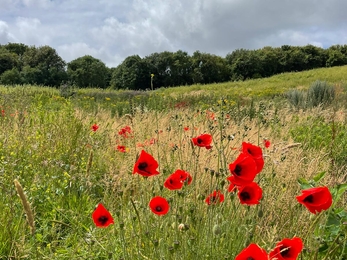‘Rewilding’ means different things to different people, but Rewilding Britain defines it as “the large-scale restoration of nature until it can take care of itself”1. It’s ripping up the fences, reintroducing the missing links, pulling the starter cord and letting the ecological machine rumble on.
‘Wilder Nunwell’, where I am currently, is one of the Trust’s rewilding sites.2 Rewilding sites don’t always sit into our categories or dutifully abide by our definitions of being “woodland” or “grassland”, they’re a melting pot of habitats.
However, to translate the tapestries of habitats here, we must meet halfway and attempt to define it, if not to better protect it.
The gentleman teaching me how to do so today is botany extraordinaire Clive Chatters.
“You can read a landscape…” he says, gesturing up the hillside. “Can you see that little scallop of bare chalk? Well, below it I wouldn’t look for anything, as it’s probably all swimming in nutrient runoff. However, on and just above it – that’s where you’ll find the exciting things.”
Later, wading through the young willow groves, Clive again references this ‘reading the landscape’.
“If you just step back and look” he says “can you see how these willows aren’t growing how one would expect, but in lines. It suggests that something has happened here. Humans for example, deal in lines.”
While Clive’s knowledge is far above my own, I have begun to pick-up some of the nuances to reading a landscape. Nettles sprouting in a field undulation for example, suggest nutrient runoff.3 Elder bushes, found in clusters, can indicate high quantities of nitrogen.4 And if you’re standing in a woodland undercut by bluebells, the trees meshing above you may have been doing so since 1600.5



